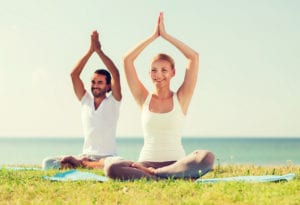Written by Joyce Smith, BS. This study suggests that while kundalini yoga (KY) may be effective for treating generalized anxiety disorder (GAD), cognitive behavior therapy (CBT) remains the treatment of choice.
 Although CBT remains the treatment of choice for GAD 1, treatments such as yoga have become an increasingly popular alternative. Not covered by the medical system, they remain cheaper, carry no stigma and are often preferred over ineffective and poorly tolerated drugs 2. While prior studies have shown complementary and alternative therapies such as mindfulness-based interventions to be efficacious for anxiety disorders, the efficacy of yoga remains less clear with very few studies supporting yoga’s health benefits. A pilot study demonstrated that KY, considered a safe, popular and accessible style of yoga encompassing all its traditional components, might improve outcomes of GAD 3,4 , yet its active mechanisms and how it compares with first line treatments such as CBT have not yet been established.
Although CBT remains the treatment of choice for GAD 1, treatments such as yoga have become an increasingly popular alternative. Not covered by the medical system, they remain cheaper, carry no stigma and are often preferred over ineffective and poorly tolerated drugs 2. While prior studies have shown complementary and alternative therapies such as mindfulness-based interventions to be efficacious for anxiety disorders, the efficacy of yoga remains less clear with very few studies supporting yoga’s health benefits. A pilot study demonstrated that KY, considered a safe, popular and accessible style of yoga encompassing all its traditional components, might improve outcomes of GAD 3,4 , yet its active mechanisms and how it compares with first line treatments such as CBT have not yet been established.
In a randomized, controlled, single-blinded clinical trial Nam and colleagues hypothesized that at a 6-month follow-up, posttreatment assessment would find KY and CBT superior to stress-management education (SE) and that KY would be non-inferior to CBT 5. The team evaluated data of 226 men and women with GAD who were randomly assigned to three groups: CBT (n=90), KY (n=93), or SE, used here as a standardized control technique (n=43). The study involved an evidence-based protocol for CBT treatment of generalized anxiety disorder, including psychoeducation, cognitive interventions (focused on identifying and adapting maladaptive thoughts and worrying), and muscle relaxation techniques. KY included physical postures, breathing techniques, relaxation exercises, yoga theory, and meditation/ mindfulness practice. The SE control group received lectures about the physiological, psychological and medical effects of stress, as well as the anti-anxiety effects of lifestyle behaviors such as reducing alcohol and smoking, and the importance of exercise and a healthy diet. Homework consisted of listening to educational material about stress, nutrition, and lifestyle. Each treatment was administered in groups of three to six participants and involved two-hour weekly sessions for a period of 12 weeks. All participants were assigned 20 minutes of daily homework.
At 3 months post intervention, both CBT and KY were found to be significantly more effective for anxiety than SE. Specifically, 54 % of those who practiced yoga met the response criteria for meaningfully improved symptoms compared to 33 % in the SE group (OR = 2.46; 95% CI, 1.12-5.42) while the response rate in the CBT group was 70.8% compared to 33% in the SE group (OR = 5; 95% CI, 2.12-11.82). At the six-month follow-up, the CBT response remained significantly better than SE (the control therapy); however, KY was no longer significantly better, suggesting that CBT may have more robust, longer-lasting anxiety-reducing effects. Based on these results, CBT remains a first-line treatment for GAD. These results are in contrast to the study hypotheses in that the team failed to find KY noninferior to CBT, yet superiority analyses could not conclusively indicate greater short-term CBT efficacy.
Findings suggest that people with GAD and their clinicians consider yoga as an option in an overall treatment plan, and since yoga’s effects may be less robust or shorter-lasting than CBT, additional intervention may be needed. However, as a short-term intervention, yoga is well –tolerated, readily available, and has health benefits beyond anxiety treatment. Further research is warranted to expand the knowledge as to who may benefit from yoga as a longer term treatment for GAD.
Source: Simon, Naomi M., Stefan G. Hofmann, David Rosenfield, Susanne S. Hoeppner, Elizabeth A. Hoge, Eric Bui, and Sat Bir S. Khalsa. “Efficacy of Yoga vs Cognitive Behavioral Therapy vs Stress Education for the Treatment of Generalized Anxiety Disorder: A Randomized Clinical Trial.” JAMA psychiatry.
© 2020 American Medical Association. All rights reserved.
Posted September 9, 2020.
Joyce Smith, BS, is a degreed laboratory technologist. She received her bachelor of arts with a major in Chemistry and a minor in Biology from the University of Saskatchewan and her internship through the University of Saskatchewan College of Medicine and the Royal University Hospital in Saskatoon, Saskatchewan. She currently resides in Bloomingdale, IL.
References:
- Hofmann SG, Smits JA. Cognitive-behavioral therapy for adult anxiety disorders: a meta-analysis of randomized placebo-controlled trials. J Clin Psychiatry. 2008;69(4):621-632.
- Gomez AF, Barthel AL, Hofmann SG. Comparing the efficacy of benzodiazepines and serotonergic anti-depressants for adults with generalized anxiety disorder: a meta-analytic review. Expert Opin Pharmacother. 2018;19(8):883-894.
- Gabriel MG, Curtiss J, Hofmann SG, Khalsa SBS. Kundalini Yoga for Generalized Anxiety Disorder: An Exploration of Treatment Efficacy and Possible Mechanisms. International journal of yoga therapy. 2018;28(1):97-105.
- Khalsa MK, Greiner-Ferris JM, Hofmann SG, Khalsa SB. Yoga-enhanced cognitive behavioural therapy (Y-CBT) for anxiety management: a pilot study. Clinical psychology & psychotherapy. 2015;22(4):364-371.
- Simon NM, Hofmann SG, Rosenfield D, et al. Efficacy of Yoga vs Cognitive Behavioral Therapy vs Stress Education for the Treatment of Generalized Anxiety Disorder: A Randomized Clinical Trial. JAMA Psychiatry. 2020.
